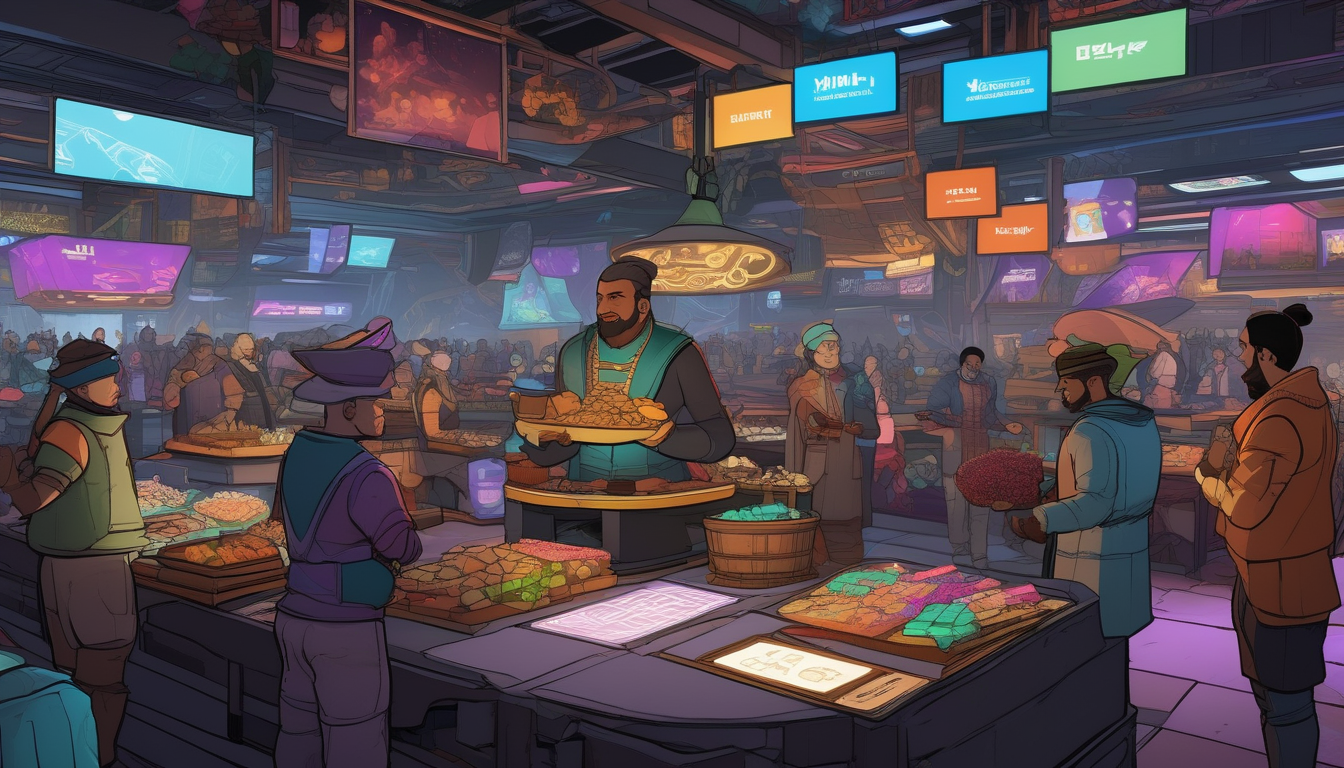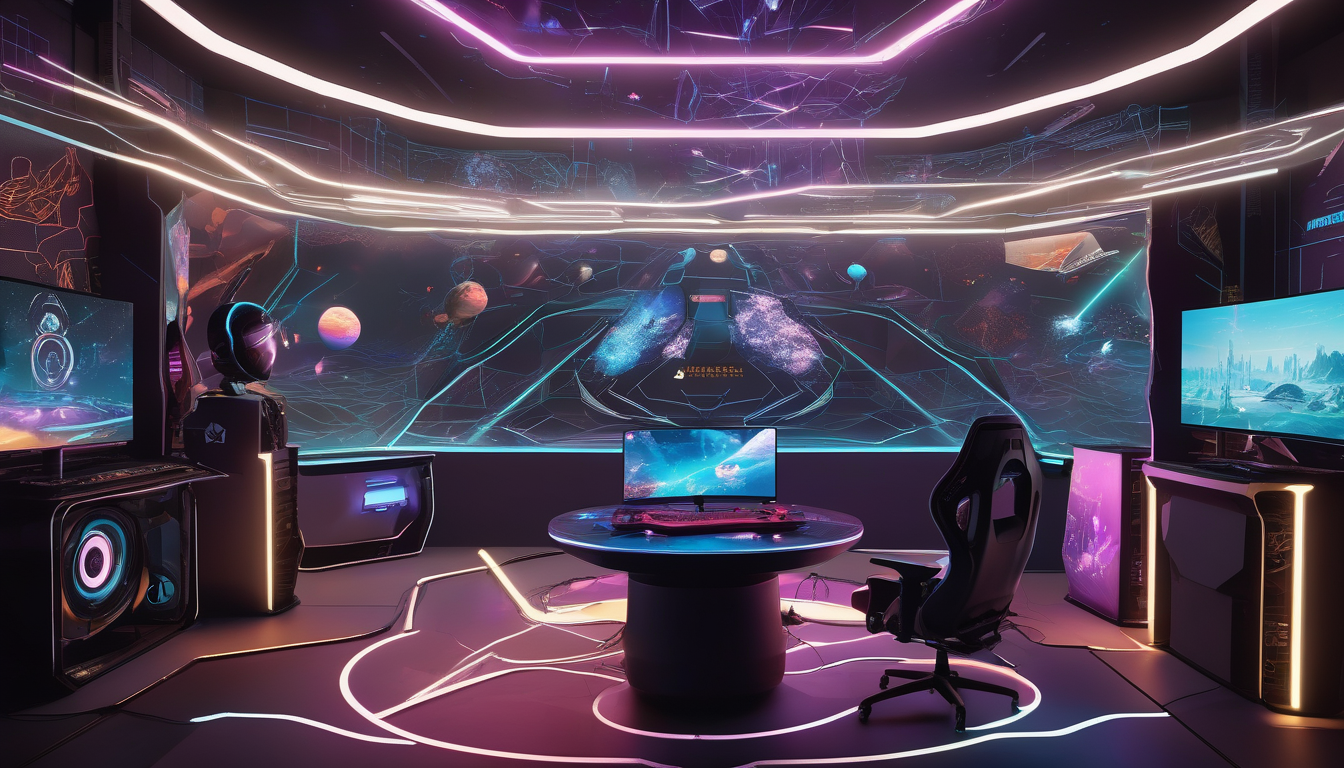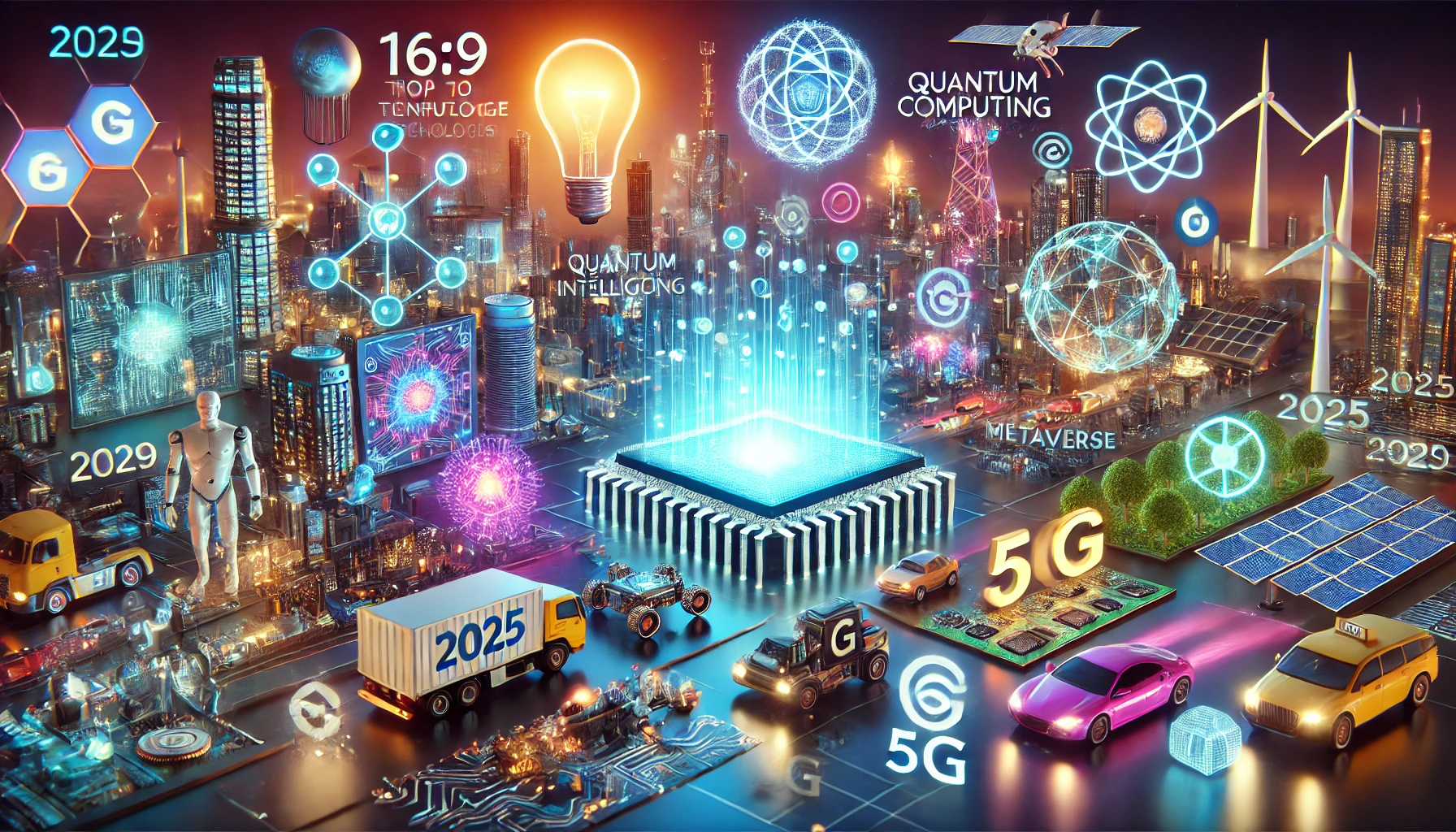Artificial intelligence (AI) is revolutionizing the gaming industry, transforming how players interact with virtual worlds. Imagine stepping into a game where the environment responds to your every move, and characters seem to have minds of their own. This is not just a dream; it’s the reality that AI is crafting. By enhancing gameplay through intelligent NPCs (non-player characters), dynamic environments, and personalized experiences, AI is making games more immersive than ever before.
Gone are the days of predictable NPCs that follow simple scripts. With advanced AI algorithms, these characters can now learn from player interactions, adapting their behavior in real-time. This makes each encounter unique, keeping players on their toes. Think of it like having a conversation with a friend who surprises you with their responses. The thrill of unpredictability adds a layer of excitement, making players feel more connected to the game world.
The journey of AI in gaming has been nothing short of remarkable. From the early days of simple algorithms that dictated NPC movements to today’s sophisticated AI systems capable of complex decision-making, the evolution is staggering. Key milestones include:
- 1980s: Introduction of basic AI in games like Pac-Man.
- 1990s: Development of more advanced AI techniques, seen in titles such as Half-Life.
- 2000s: Emergence of AI-driven games that adapt to player behavior.
As we look ahead, the potential for AI in gaming seems limitless. Developers are continuously pushing boundaries, creating not just games, but entire worlds that players can lose themselves in. The future promises even more innovations, such as enhanced procedural content generation and dynamic difficulty adjustments, ensuring that every gaming session feels fresh and engaging.
In conclusion, AI is not just a tool; it’s the backbone of the next generation of gaming experiences. As technology continues to advance, players can expect more immersive, intelligent, and personalized adventures that redefine what it means to play.

The Evolution of AI in Gaming
When we think about the evolution of artificial intelligence in gaming, it’s like tracing the footsteps of a pioneer venturing into uncharted territory. From the early days of simple algorithms that dictated the movements of non-player characters (NPCs) to today’s sophisticated systems that create entire worlds, the journey has been nothing short of remarkable. Back in the 1980s, games like Pong and Pac-Man used basic AI to provide a semblance of challenge. Those games were a mere glimpse into what was possible, acting as the stepping stones toward the complex AI we see today.
Fast forward to the 1990s, and we witnessed a significant leap with titles like Final Fantasy VII and Half-Life. These games introduced more advanced AI techniques, allowing NPCs to react to player actions in a way that felt more organic. The introduction of pathfinding algorithms and decision trees enabled characters to navigate environments intelligently, enhancing the overall gaming experience.
As we entered the 2000s, the gaming industry began to embrace machine learning and neural networks. This shift allowed developers to create AI that could learn from player behavior, adapting and evolving over time. Games like The Sims and Left 4 Dead showcased how AI could not only control NPCs but also create dynamic narratives that changed based on player choices.
Today, we stand on the brink of a new era, where AI is not just an add-on but a core component of game design. With the rise of procedural content generation and dynamic difficulty adjustment, the potential for immersive gameplay is limitless. As we look to the future, we can only imagine how AI will continue to transform our gaming experiences, making them more personalized and engaging than ever before.

AI-Driven NPC Behavior
Imagine stepping into a game where the non-player characters (NPCs) don’t just stand around waiting for your next move. Instead, they react, adapt, and evolve based on your actions. This is the magic of . Gone are the days of predictable, robotic interactions; today’s NPCs are smarter, more dynamic, and incredibly engaging.
At the heart of this transformation lies advanced AI algorithms that analyze player behavior and context. These algorithms allow NPCs to learn from their surroundings and adjust their actions accordingly. For instance, if you tend to sneak around, an NPC might become more vigilant, setting traps or calling for help. This creates a sense of realism that pulls players deeper into the game world, making every encounter feel unique and thrilling.
Moreover, AI-driven NPCs can exhibit a range of emotions and personalities. Picture a friendly villager who becomes anxious when a monster is spotted, or a rival who taunts you based on your previous failures. This emotional depth not only enhances immersion but also builds a stronger connection between players and the game. As players, we crave these interactions that feel genuine and responsive.
To illustrate the impact of AI on NPC behavior, consider the following table:
| NPC Behavior Type | Description |
|---|---|
| Adaptive Learning | NPCs learn from player actions and modify their strategies. |
| Emotional Responses | NPCs react emotionally to player decisions, enhancing realism. |
| Dynamic Interactions | Conversations and actions change based on player history. |
In essence, AI-driven NPC behavior is revolutionizing the way we experience games. It makes the virtual world feel alive, turning every player into a part of a larger, ever-evolving story. As technology continues to advance, we can only imagine how much more immersive these interactions will become. Are you ready to dive into a world where every NPC has a story to tell?
Procedural Content Generation
Procedural Content Generation (PCG) is revolutionizing the gaming landscape by allowing developers to create expansive and unique game worlds with relative ease. Imagine stepping into a game where every time you play, the environment is different, offering fresh challenges and discoveries. This is precisely what PCG achieves. By utilizing complex algorithms, games can generate landscapes, quests, and even entire narratives on the fly, ensuring that no two gaming experiences are ever the same.
The beauty of PCG lies in its ability to enhance replayability. Players are more likely to return to a game that offers new experiences with each session. For instance, in games like No Man’s Sky, entire planets are generated procedurally, featuring unique flora, fauna, and terrains. This not only keeps players engaged but also fosters a sense of exploration and discovery reminiscent of a treasure hunt.
Furthermore, PCG can significantly reduce the workload for developers. Instead of painstakingly designing every detail of a game world, they can focus on creating robust algorithms that generate content dynamically. This shift allows for more resources to be allocated towards enhancing gameplay mechanics and improving overall game quality.
However, it’s essential to note that while PCG offers many advantages, it also comes with challenges. The generated content must still feel cohesive and meaningful to the player. Otherwise, it risks becoming a chaotic jumble that detracts from the gaming experience. Developers must strike a balance between randomness and structure to ensure that players remain immersed.
In summary, is not just a buzzword; it’s a game-changer. By creating immersive and varied environments, PCG enhances player engagement and satisfaction, paving the way for a future where every game feels like a unique adventure. The possibilities are endless, and as technology continues to evolve, we can expect even more innovative uses of PCG to emerge in the gaming industry.
Dynamic Difficulty Adjustment
Have you ever found yourself stuck in a game, feeling like you’re banging your head against a wall? Or maybe you’ve breezed through a level so easily that it felt more like a chore than a challenge? Dynamic Difficulty Adjustment (DDA) is the hero that swoops in to save the day, ensuring that your gaming experience is perfectly tailored to your skill level. Imagine a game that knows just how to keep you on your toes, providing the right amount of challenge to keep you engaged without overwhelming you.
At its core, DDA uses advanced AI algorithms to monitor your gameplay in real-time. It analyzes various factors, such as your success rate, the time you take to complete tasks, and even how often you hit a snag. Based on this data, the game can adjust its difficulty level dynamically. This isn’t just a gimmick; it’s a game-changer that transforms the way players interact with their favorite titles.
So, how does it work? Let’s break it down:
- Real-Time Monitoring: The game keeps an eye on your performance, tracking your victories and defeats.
- Adaptive Challenges: If you’re breezing through, the game might throw in tougher enemies or more complex puzzles.
- Supportive Adjustments: Conversely, if you’re struggling, it could provide helpful hints or tone down enemy strength.
This intelligent approach not only enhances player satisfaction but also fosters a sense of achievement. Players can enjoy the thrill of overcoming obstacles without the frustration of an insurmountable challenge. Just like a good coach, DDA knows when to push you harder and when to give you a little nudge in the right direction. As technology continues to evolve, the future of DDA looks promising, paving the way for even more immersive and personalized gaming experiences.
Realistic Animation and Physics
When you think about gaming, what truly pulls you into the experience? It’s not just the storyline or graphics; it’s the realism that makes you feel like you’re part of another world. Thanks to advancements in artificial intelligence, realistic animation and physics have reached new heights, transforming the way we interact with digital environments. Imagine a game where every character’s movement feels fluid and natural, as if they were real people walking around. This is where AI shines, creating lifelike animations that respond dynamically to player actions.
AI algorithms analyze a multitude of factors—from the character’s surroundings to their emotional state—to produce animations that are not only visually appealing but also contextually appropriate. For instance, if a character is running away from danger, AI can adjust their movements to reflect urgency and fear. This level of detail enhances immersion, making players feel as if they are genuinely part of the action.
Moreover, physics engines powered by AI contribute significantly to this realism. They simulate how objects interact with each other and the environment, allowing for scenarios that feel authentic. For example, when a character jumps onto a moving platform, the physics engine ensures that their weight and momentum are accurately represented, creating a believable experience. This is crucial in games where realistic interactions are essential for player engagement.
To illustrate the impact of AI on animation and physics, consider the following table that outlines key advancements:
| Advancement | Description |
|---|---|
| Motion Capture Technology | Utilizes AI to process and enhance real-life movements for characters. |
| Procedural Animation | Generates animations in real-time based on player input and environment. |
| Physics Simulation | Realistically models how objects move and interact within the game world. |
In conclusion, the integration of AI in realistic animation and physics not only enriches the visual experience but also deepens player engagement. As technology continues to evolve, we can only imagine the breathtaking worlds that await us, where every action feels real and every interaction is meaningful.
Personalized Gaming Experiences
Imagine stepping into a game where every choice you make, every path you take, feels uniquely yours. are revolutionizing how players engage with their favorite titles, making each session not just a game, but a personal journey. Thanks to advanced artificial intelligence, developers can analyze player behavior, preferences, and even emotional responses to tailor experiences that resonate deeply.
At the heart of this transformation lies data. AI algorithms sift through mountains of data, identifying patterns in how players interact with games. This information allows developers to create dynamic narratives that adapt based on player decisions. For instance, if a player frequently chooses stealthy approaches, the game might introduce more stealth-based challenges, enhancing the sense of immersion and ownership over the experience.
Moreover, personalized experiences extend beyond just gameplay mechanics. They also encompass visual and auditory elements. Imagine a game that adjusts its soundtrack based on your in-game actions or one that changes its visual style to match your mood. This level of customization not only keeps players engaged but also fosters a deeper emotional connection to the game.
Here are a few ways AI personalizes gaming experiences:
- Adaptive Storytelling: The narrative evolves based on player choices, making each storyline unique.
- Customizable Difficulty: AI adjusts the game’s challenge level in real-time based on player skill.
- Tailored Rewards: Players receive rewards that align with their play style, enhancing motivation.
As we look ahead, the potential for personalized gaming experiences is boundless. With AI continuing to evolve, we can expect even more sophisticated systems that not only understand players but anticipate their desires. This future promises not just games, but immersive worlds that feel alive and responsive, inviting players to explore, engage, and enjoy like never before.

The Future of AI in Gaming
As we gaze into the crystal ball of gaming, one thing is clear: artificial intelligence is set to revolutionize the landscape even further. Imagine a world where games adapt not just to your skills but to your emotions, creating a truly personalized experience. With advancements in machine learning and neural networks, we are on the brink of a gaming renaissance that will make our current experiences seem rudimentary.
One exciting prospect is the emergence of fully autonomous NPCs that learn from players over time. These characters won’t just follow pre-programmed scripts; they’ll evolve based on your interactions. Picture a game where your choices influence an NPC’s personality, creating a unique storyline that feels alive. This level of immersion could redefine how we engage with narratives, making every playthrough a fresh adventure.
Moreover, the integration of AI-driven analytics will allow developers to understand player behavior in real-time. By analyzing how players interact with the game, developers can implement dynamic content updates that keep the experience fresh and engaging. This could lead to a future where games are never truly finished; instead, they evolve alongside their players.
In addition, we can expect advancements in virtual reality (VR) and augmented reality (AR) to be powered by AI. Imagine strapping on a VR headset and entering a world where the environment reacts to your every move and choice. AI can create realistic weather patterns, dynamic NPC interactions, and even personalized quests based on your past decisions. The line between reality and gaming will blur, offering an experience that is not only immersive but also deeply personal.
As we look ahead, the possibilities seem endless. The future of AI in gaming promises to create experiences that are not just played but felt. Are you ready to step into a world where games know you better than you know yourself?
Frequently Asked Questions
- How does AI enhance gaming experiences?
AI enhances gaming experiences by creating immersive worlds, making non-player characters (NPCs) more intelligent, and personalizing gameplay. This means players can enjoy a more interactive and engaging environment, where every decision can lead to unique outcomes.
- What is procedural content generation?
Procedural content generation is a method where AI algorithms create vast and unique game worlds on the fly. This not only boosts replayability but also encourages players to explore different paths and experiences each time they play.
- Can AI adjust the difficulty of a game?
Absolutely! AI can assess a player’s performance in real-time and adjust the game difficulty accordingly. This ensures that players are always challenged, but not overwhelmed, leading to a more satisfying gaming experience.
- What role does AI play in NPC behavior?
AI plays a crucial role in enabling NPCs to exhibit realistic behaviors. This means that NPCs can react dynamically to player actions, making interactions feel more natural and engaging.
- How does AI personalize gaming experiences?
AI personalizes gaming by analyzing player behavior and preferences, allowing games to tailor experiences that resonate with individual players. This personalization can lead to deeper emotional connections with the game.
- What does the future hold for AI in gaming?
The future of AI in gaming looks bright! We can expect innovative advancements that will further enhance realism, interactivity, and personalization, ultimately transforming how players engage with games.



